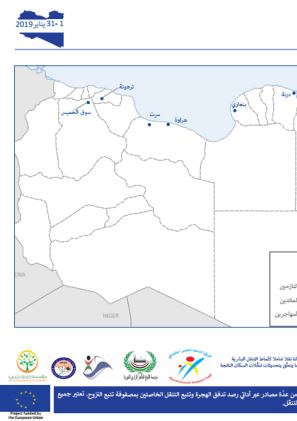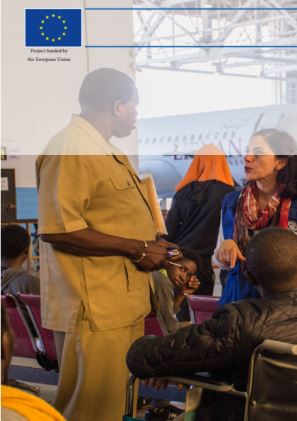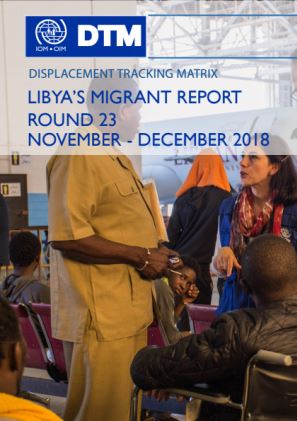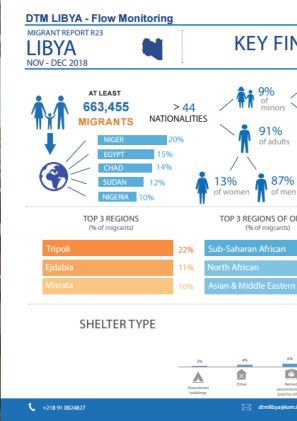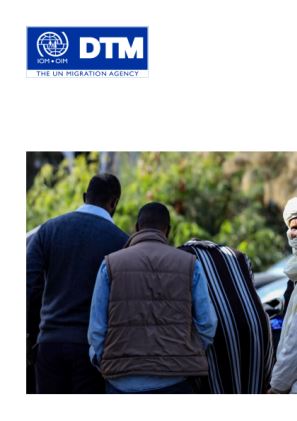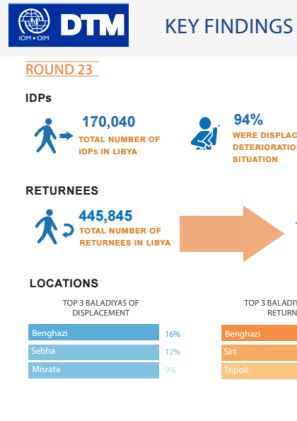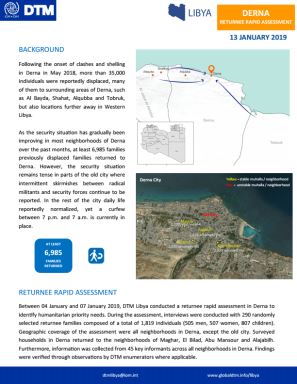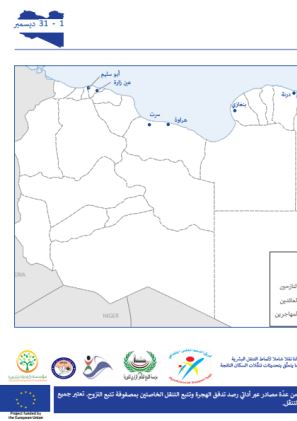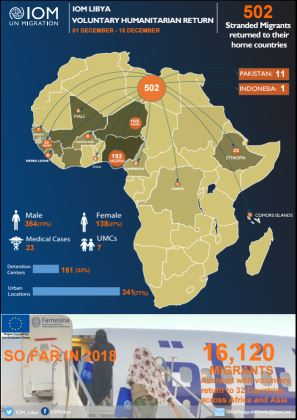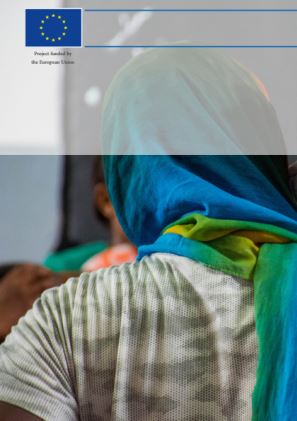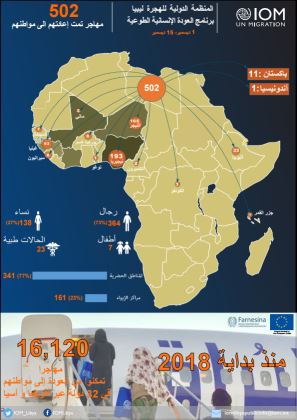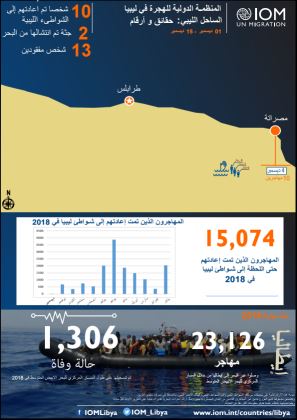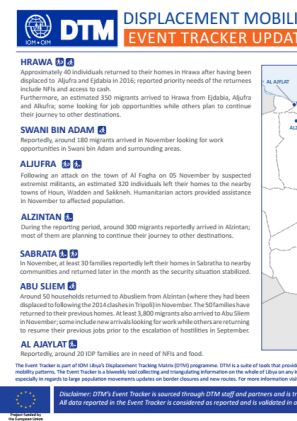-
Countries
-
Data and Analysis
-
Special Focus
-
Crisis Responses
Libya
À propos Libya
Libya is a geographically vast country with several regions that are difficult to access. In order to understand the full scope of humanitarian assistance that is needed throughout the country, IOM established the Displacement Tracking Matrix (DTM) programme in 2016 in order to provide a common operating picture concerning the movement of populations in Libya, allowing humanitarian actors to provide timely assistance to those in need. Following the escalation of conflict and insecurity in 2014, the security situation has remained volatile since with fluctuations in the intensity of localized clashes. Congruently, conflict has caused new displacements, often in areas ill-equipped to accommodate large population movements while also negatively impacting the large migrant population residing and transiting through Libya. More recently, the capital Tripoli was heavily affected by displacement waves in September 2018 and April 2019.
DTM’s mobility tracking and flow monitoring activities identified many migrants in-country to be in need of various forms of assistance. Libya’s geographic location, resources and work opportunities has made it both a country of destination and transit for migrants for many years. Despite the deterioration of the security situation since 2011 migrants continue coming to and transiting through Libya, the majority from Sub-Saharan and North African countries.
In this complex operating environment, DTM Libya has been providing a common operating picture concerning the movement of populations in Libya since 2016, allowing humanitarian actors to provide timely assistance to those in need. Through its mobility tracking, flow monitoring and needs assessment activities, DTM Libya has established itself as data hub for quantitative data on migratory flows to and within Libya, migrant presence in Libya disaggregated by nationality and area, as well as humanitarian needs of migrants, internally displaced population and returnees. All activities are implemented through periodical bi-monthly data collection cycles, allowing trend analysis over time to provide evidence-base for both policy-level discussions and to guide humanitarian action.
In order to facilitate humanitarian interventions, DTM works closely with IOM’s other programmes through referring identified populations in need of assistance at flow monitoring points to IOM’s Direct Assistance, Health, Voluntary Humanitarian Return (VHR), Protection and Migrant Rapid Response Mechanism (MRRM) programmes. Furthermore, DTM Libya supports other humanitarian partners through providing emergency tracking updates in case of sudden population movements as well as facilitating humanitarian assessments for the Rapid Response Mechanism (RRM) jointly implemented by IOM, UNICEF, WFP and UNFPA.
For more information on IOM's activities in Libya, please visit the IOM Libya country office website.
Contacter
DTM Libya
DTMLibya@iom.int
Current Donors
- EUTF
Libya — Displacement Event Tracking Report (1- 31 Jan 2019)
Approximately 990 migrants reportedly arrived in Benghazi in January 2019 looking for work opportunities. The security situation in most neighbourhoods of Derna remained stable during the reporting period, except the old city.
Libya — Displacement Event Tracking Report (1- 31 Jan 2019) [Arabic]
خلال شهر يناير من سنة 2019، بلغنا وصول قرابة 990 مهاجرا إلى بنغازي في إطار بحثهم عن سُبُل لكسب الرّزق. ظلّ الوضع الأمني في أغلب أحياء درنة مستقّر خلال الفترة المشمولة بالتقرير باستثناء المدينة القديمة.
Libya — Migrant Report 23 (Nov - Dec 2018) - Arabic
أجريت الجولة الثالثة والعشرين لتجميع البيانات الخاصّة بالهجرة خلال شهري نوفمبر وديسمبر من سنة .2018 وتمكّنت مصفوفة تتبّع النزوح من إحصاء ما لا يقلّ عن 663.445 مهاجرا موجودين حاليا في جميع بلديات ليبيا وفي داخل 571 محلّة. ويعود أصل المهاجرين إلى أكثر من 44 دولة.
Libya — Migrant Report 23 (Nov - Dec 2018)
In Round 23, DTM identified there to be at least 663,455 migrants in Libya. Migrants were identified in all baladiyas, within 571 communities and originated from more than 44 countries.
Feb 06 2019
Libya — Migrant Report 23 (Nov - Dec 2018)
Migrant Report Key Findings 23 (Nov - Dec 2018)
DTM Libya Round 23 Key Findings
Feb 06 2019
Migrant Report Key Findings 23 (Nov - Dec 2018)
Libya — IDP and Returnee Report 23 (Nov-Dec 2018) [Arabic]
يستعرض هذا التقرير نتائج الجولة الثالثة والعشرين المستخلصة من عمل وحدة تتبّع التنقل الخاصّة بمصفوفة تتبع النزوح في ليبيا والتي تغطّي الفترة الممتدة بين شهري نوفمبر وديسمبر . من سنة 2018 وفي الجولة الثالثة والعشرين، ارتفع عدد العائدين في ليبيا من 403,978 فردا ليبلغ 445,845 عائدا.
Libya — IDP and Returnee Key Findings Report 23 (November - December 2018)
This report presents the findings of round 23 of the mobility tracking component of the Displacement Tracking Matrix (DTM) in Libya, covering the reporting period November
Libya — IDP and Returnee Report 23 (November - December 2018)
This report presents the findings of round 23 of the mobility tracking component of the Displacement Tracking Matrix (DTM) in Libya, covering the reporting period November
Returnee Rapid Assessment (January 2019)
Between 04 January and 07 January 2019, DTM Libya conducted a returnee rapid assessment in Derna to identify humanitarian priority needs.
Jan 16 2019
Returnee Rapid Assessment (January 2019)
Libya — Displacement Event Tracking Report (1-31 Dec) [Arabic]
About 4,400 migrants arrived to Abu Sliem during the reporting period, 6,300 migrants arrived to Ain Zara, 150 Migrants to Hrawa ,250 to Sirt and 500 to Benghazi.
Libya — Displacement Event Tracking Report (1-31 Dec)
About 4,400 migrants arrived to Abu Sliem during the reporting period, 6,300 migrants arrived to Ain Zara, 150 Migrants to Hrawa ,250 to Sirt and 500 to Benghazi.
Libya — Detention Centre Profile Generator (December 2018)
Detention Centre Profiling is a component of IOM Libya's Displacement Matrix programme. It is a data oriented tool that routinely provides specific sex and age demographic data and key sectorial information on individuals held in Libya's detention Centres.
Libya — Voluntary Humanitarian Return Update (1-15 December 2018)
This fact sheet provides a bi-weekly update on Voluntary Humanitarian Returns carried out by IOM Libya. During the reporting period, 502 stranded migrants were assisted to return to their home countries.
Libya — Maritime Update Libyan Coast (1-15 December 2018)
This fact sheet provides a bi-weekly update on migration-related events off the Libyan coast. During the reporting period, 10 migrants were returned to the Libyan shore, 2 bodies were retrieved and 13 migrants went missing at sea.
Libya — Migrant Report 22 (Arabic) (Sep - Oct 2018)
تمكنت مصفوفة تتبع النزوح من إحصاء وجود ما لا يقلّ عن 670.920 مهاجرا في ليبيا خلال الجولة الـ22. وقد توزّع المهاجرون في كلّ البلديات في ليبيا داخل 558 محلّة. وانحدر أصلهم من أكثر من 39 بلدا.
Libya — Voluntary Humanitarian Return Update (1-15 December 2018) [Arabic]
This fact sheet provides a bi-weekly update on Voluntary Humanitarian Returns carried out by IOM Libya. During the reporting period, 502 stranded migrants were assisted to return to their home countries.
Libya — Maritime Update Libyan Coast (1-15 December 2018) [Arabic]
This fact sheet provides a bi-weekly update on migration-related events off the Libyan coast. During the reporting period, 10 migrants were returned to the Libyan shore, 2 bodies were retrieved and 13 migrants went missing at sea.
Libya — Migrant Report Key Findings R22 (Sep - Oct 2018)
Migrant Report Round 22 Key Findings
Libya — Migrant Report 22 (Sep - Oct 2018)
In Round 22, DTM identified there to be at least 670,920 migrants in Libya. Migrants were identified in all baladiyas, within 558 communities and originated from more than 39 countries.
Dec 19 2018
Libya — Migrant Report 22 (Sep - Oct 2018)
Libya — Detention Centre Profile Generator (November 2018)
Detention Centre Profiling is a component of IOM Libya's Displacement Matrix programme. It is a data oriented tool that routinely provides specific sex and age demographic data and key sectorial information on individuals held in Libya's detention Centres.
Libya — Displacement Event Tracking Report (1-30 November) [Arabic]
Approximately 40 individuals returned to their homes in Hrawa after having been displaced to Aljufra and Ejdabia in 2016; reported priority needs of the returnees include NFIs and access to cash.
Libya — Displacement Event Tracking Report (1-30 November)
Approximately 40 individuals returned to their homes in Hrawa after having been displaced to Aljufra and Ejdabia in 2016; reported priority needs of the returnees include NFIs and access to cash.
Libya — IDP and Returnee Report 22 (September - October 2018)
This report presents the findings of Round 22 of DTM data collection,which took place in September and October 2018. During the reporting period the number of identified returnees in Libya increased to 403,978 (+21,756), largely due to a return movement in Derna following
Libya — IDP and Returnee Report 22 (September - October 2018)
يعرض هذا التقرير نتائج الجولة 22 من جمع بيانات DTM ، التي جرت في سبتمبر وأكتوبر 2018. وخلال الفترة المشمولة بالتقرير ، ارتفع عدد العائدين المحددين في ليبيا إلى 403،978 (+21،756) ، ويرجع ذلك إلى حد كبير إلى حركة العودة في درنة بعد
Pagination
Pagination
- First page
- Previous page
- 1
- 2
- 3
- 4
- 5



